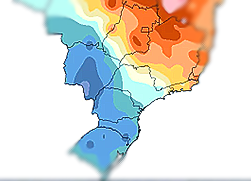It’s Cold in Brazil
This week, Brazil is experiencing unusually cold weather.
In the southern and southeastern regions, temperatures have dropped below freezing.
In the state of Santa Catarina, temperatures of -4°C were recorded in the early hours of Tuesday, while in Paraná and Rio Grande do Sul, night frost has created glistening landscapes. Such cold spells do not occur every year in Brazil, but they do occur every few years. According to meteorologists, a cold front typically reaches the southern regions once every two to three years. Just how cold it gets depends on the strength of the cold air blowing northwards from Patagonia and the South Pole. Minimum temperatures often dip just below freezing, but in some mountainous areas, they can fall to -5°C or even lower.
Brazil is known for its tropical warmth and vast beaches, not for icy nights and frozen plants. Yet every winter, the country’s southern states face a few frosty days when cold air from Patagonia sweeps inland. Sometimes the cold even reaches the central-western states such as Goiás and Mato Grosso do Sul, but there it usually remains cool rather than frosty. In the tropical north and northeast, little changes – it stays warm and humid as always.
The cold snap not only brings picturesque images of snow-dusted hills and ice on windowpanes, but also poses challenges for farmers and vulnerable groups. Coffee growers fear frost damage to their plantations, while people living on the streets are particularly at risk. As a result, municipalities have opened emergency shelters to protect people from the cold.
At the same time, the cold spell offers another perspective: it reminds us of Brazil’s immense diversity. From tropical heat in the north to wintry chill in the south, the country is marked by extreme contrasts. And it is precisely this variety that is a key strength of the Brazilian economy. Farmers in the south know how to deal with frost, just as their counterparts in the north manage rainfall and drought. The cold snap reveals how weather and climate shape not only the landscape, but also the resilience and ingenuity of the people who live there.
For companies active in Brazil, this holds a lesson: flexibility is essential. Projects that promote climate-resilient agriculture or sustainable energy are not merely relevant – they are vital. This week’s cold snap is a good example of how natural forces can bring sudden challenges. But it is also an opportunity to harness local knowledge and international cooperation to mitigate the impact.
In the coming days, the cold will slowly subside, but the message remains: in a country as vast and diverse as Brazil, one must always be prepared for the unexpected. Those who understand this well can seize opportunities while contributing to a more resilient and beautiful future.




